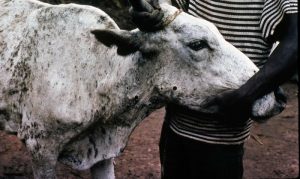Lumpy Skin Disease:

Around 1,229 cattle across five districts of Gujarat have been infected with Lumpy Skin Disease (LSD).
Lumpy Skin Disease:
- LSD is caused by infection of cattle or water buffalo with the poxvirus Lumpy Skin Disease Virus (LSDV).
- According to the Food and Agriculture Organization (FAO), The mortality rate is less than 10%.
- Lumpy skin disease was first seen as an epidemic in Zambia in 1929. Initially, it was thought to be the result of either poisoning or hypersensitivity to insect bites.
- Lumpy skin disease is primarily spread between animals by biting insects (vectors), such as mosquitoes and biting flies.
- Symptoms:
- It primarily consists of fever, fluid excretion from eyes and nose, dribbling of saliva from the mouth and blisters on the body.
- The animal stops eating and faces problems while chewing or eating, resulting in reduced milk production.
- Prevention and Treatment:
-
- Vaccination against these diseases is covered under the Livestock Health and Disease Control Programme of India.
- There are no specific antiviral drugs available for the treatment of lumpy skin disease.
- The only treatment available is supportive care of cattle.
- This can include treatment of skin lesions using wound care sprays and the use of antibiotics to prevent secondary skin infections and pneumonia.




